
•Year started: 2003
•Location: Osaki City, Miyagi Prefecture
•Actor : Shimpo Community Fuyu-Mizu-Tambo Growers' Association
Located along the Kitakamigawa River system in Miyagi Prefecture, Kabukuri-numa is a wetland of 150 hectares, which is for the most part covered with reed and Indian rice and embraced by rice paddies that were once part of the wetland.
Kabukuri-numa is home to more than 220 bird species, including the white-fronted goose, a protected species in Japan, and 127 endangered species, such as killfish and zenitanago. In 2005, a winter roosting site for the white-fronted geese, Kabukuri-numa and surrounding rice paddies were collectively registered as a wetland under the Ramsar Convention[1] which aims to conserve internationally important habitats for waterfowl. By flooding surrounding paddy fields during wintertime[2] in order to disperse the roosts of the white-fronted geese, the wetland has been successfully restored. These efforts have contributed to the development of a new concept - "agricultural wetlands," encompassing both agricultural and wetland functions.
Migratory birds, the white-fronted geese began to descend upon Kabukuri-numa in smaller numbers, but as wetlands disappeared, they crowded together in particular winter roosts. According to studies conducted by Miyagi Prefecture, 60 percent of white-fronted geese migrating to Japan spent the winter in Kabukuri-numa in 2005. Because a high concentration of migratory birds can increase the risks of widespread transmission once an epidemic bursts among birds, as well as cause water contamination, surrounding rice paddies not growing any crops during the wintertime were flooded with water in order to disperse the roosts of the geese. This method of flooding winter paddies with water is known as "fuyu-mizu-tambo."
Initiated with the aim of increasing roosts for migrating birds flocking together, the "fuyu-mizu-tambo" method has proven to have other advantages as well. For example, swans come to rest during the day, leaving behind their droppings, which contain soil-enriching phosphoric acid. Because the birds feed on weeds, herbicides have proven to be no longer necessary. Through the introduction of the "fuyu-mizu-tambo" method, farmers have found a way to coexist with geese, which had been considered a nuisance for a long time.
"Fuyu-mizu-tambo" has enriched the rice paddy ecosystem, therefore attracting more herons and other summer birds that feed on aquatic organisms living in paddy fields. Another factor that has contributed to the steady increase of white-fronted geese descending upon Kabukuri-numa is the restoration of the rice paddies of Shiratori district (a flood-control basin) as a wetland in 1998[3].
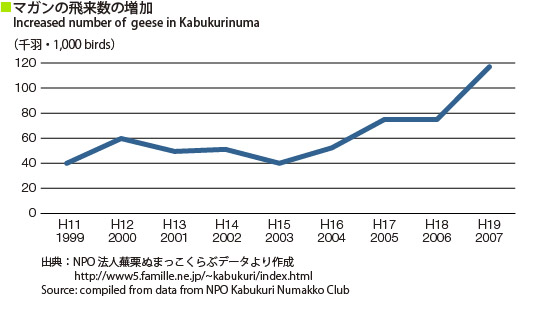
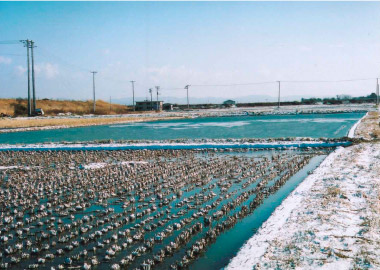
Photo: "Fuyu-mizu-tambo"- flooding winter paddiesy © Osaki City
"Fuyu-mizu-tambo" means paddies flooded with water in wintertime. This agricultural method requires farmers to flood winter paddies with water, providing a rich habitat for a variety of organisms, such as fungi, sludge worms and frogs, the activities of which create natural fertilizers, inhibit weed growth and prevent pest infestation. This enables farmers to produce safe, high-quality rice without using agricultural pesticides and chemical fertilizers, therefore living in harmony with nature.
Only 50-60 kilograms of seeds are planted per seedling box in order to grow cold weather-resistant seedlings which are planted one or two at a time, in smaller bunches compared to conventional methods. Sixty kilograms of rice bran and 50 kilograms of crushed soya are put into every 1,000 square meters of field before the paddies are flooded, maintaining a depth of five centimeters, during the months of December through February. It is believed that putting rice bran and crushed soya into the soil activates sludge worms, which develop a slimy fecal layer into which weed seeds are buried, therefore preventing their germination and consequently inhibiting weed growth.
The "fuyu-mizu-tambo" method was introduced in 1998 as a voluntary effort by individual farmers until the Shimpo district decided to apply it in the entire district from the winter of 2003/2004.
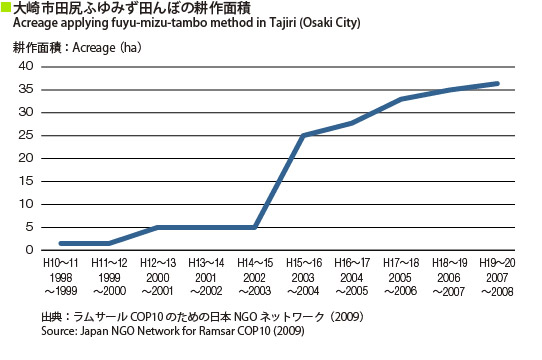
Farmers have actually experienced a yield loss of 150 kilograms per 1,000 square meters from 570 kilograms per 1,000 square meters under conventional production methods. However, this is considered not only a consequence of agrichemical-free farming but also a result of planting smaller bunches of seedlings. As of fiscal year 2009, farmers adopting the "fuyu-mizu-tambo" method are offered a grant for local development of 8,000 yen per 1,000 square meters of rice fields that use no agricultural pesticides or chemical fertilizers and are flooded during the winter. Osaki City offers a grant of 5,000 yen per 1,000 square meters to accommodate costs for the acquisition of third-party certification for non-use of pesticides and chemical fertilizers. Under the grant for Action Plan for Improvements in Farmland, Water and Environmental Conservation, farmers are entitled to 4,400 yen per 1,000 square meters for cooperative work and 6,000 yen per 1,000 square meters for winter-flooding and non-tilling farming.
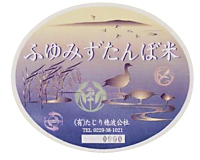 The rice grown in winter-flooded paddy fields are sold at
a premium price of 23,000-24,000 Japanese yen,
compared to approximately 14,000 Japanese yen for rice
grown with conventional methods[4], consequently
providing farmers a stable source of revenue. Distribution
routes have also become established: JA (Japan
Agricultural Cooperatives) Midorino sells premium rice to
Pal System Consumers Cooperative Union based in the
Tokyo metropolitan area, and a local firm, Tajiri Honami
Kosha, sells it to natural food stores and other specific
clients as well as on the Internet. Other rice products,
including Japanese rice wine have also been marketed.
The rice grown in winter-flooded paddy fields are sold at
a premium price of 23,000-24,000 Japanese yen,
compared to approximately 14,000 Japanese yen for rice
grown with conventional methods[4], consequently
providing farmers a stable source of revenue. Distribution
routes have also become established: JA (Japan
Agricultural Cooperatives) Midorino sells premium rice to
Pal System Consumers Cooperative Union based in the
Tokyo metropolitan area, and a local firm, Tajiri Honami
Kosha, sells it to natural food stores and other specific
clients as well as on the Internet. Other rice products,
including Japanese rice wine have also been marketed.
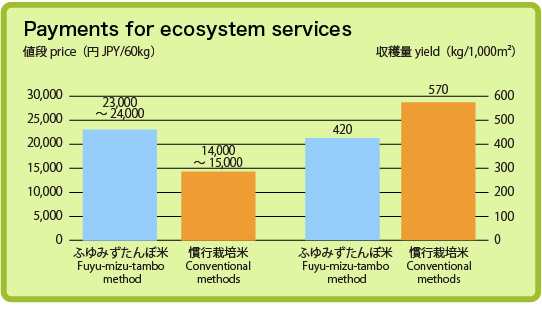
Another effort in Kabukurinuma is the Rice Paddy Organism Survey, in which participants look for different creatures living in a rice paddy and keep a record of numbers sighted in order to get an idea of the biodiversity of the site. Launched in 2005 as a producer-oriented activity to check for living creatures in a rice paddy the effort was expanded to become a program involving consumers in 2008.
In December, 2009, the Rice Paddy Organism Survey Project[5], announced the "Tajiri Declaration on 'Life in the Rice Paddy' " The declaration aims to promote common awareness towards the significance and great potential of biodiversity in paddy fields and to communicate to future generations that all phenomena, including humans, are constantly changing. It comprises ten items, including, of course, developing safe and rich soil and also preserving the diversity of the complex Satoyama ecosystem, considering the environment of rice paddies and surrounding areas, contributing to the mitigation of climate change, preserving local culture and promoting the direct delivery of fresh local produce. It is the first declaration in Japan that pledges to adopt agricultural methods that will allow coexistence with creatures living in the rice paddies.
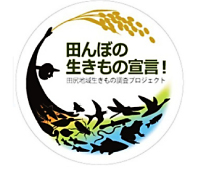 In order to publicize this new concept, a "Life in the rice paddy" logo has been designed.
and placed on packages of rice produced in the Tajiri district and sold by Tohto Co-op as of
February 2010. The logo represents how humans and rice paddies are both supported by
biodiversity. The colors used in the background are: blue for water, green for plants and
brown for the land, depicting a "nostalgic" future that we should endeavor to realize.
In order to publicize this new concept, a "Life in the rice paddy" logo has been designed.
and placed on packages of rice produced in the Tajiri district and sold by Tohto Co-op as of
February 2010. The logo represents how humans and rice paddies are both supported by
biodiversity. The colors used in the background are: blue for water, green for plants and
brown for the land, depicting a "nostalgic" future that we should endeavor to realize.
[1]The Convention on Wetlands of International Importance, known as the Ramsar Convention, is an
intergovernmental treaty that provides the framework for national action and international cooperation
for the conservation and wise use of wetlands and their resources. It was adopted in the Iranian city of
Ramsar in 1971 and came into force in 1975, and it is the only global environmental treaty that deals
with a particular ecosystem. As of February 2, 2010, 159 countries are parties to the convention under
which 1,886 wetlands covering a total of approximately 185,156,612 hectares have been registered. The
convention's member countries cover all geographic regions of the world.
[2]Most of the rice paddies converted from wetlands were originally wet-paddies, but in the course of
technological developments in civil engineering, dry paddies gradually became common.
[3]Approximately 50 hectares of land which had been used as rice paddies until the season of 1997 in
the Shiratori district were restored as wetlands in the spring of 1998 by shallowly retaining water.
[4]Agricultural methods using a standard amount of agricultural pesticides and chemical fertilizers as
stipulated in regional guidelines determined by the local government.
[5]Members include JA Midorino, National Federation of Agricultural Cooperative Associations
(ZEN-NOH), Tohto Co-op, Miyagi Co-op, Pearl Rice Miyagi, ZEN-NOH Pearl Rice East Japan CORP.,
JA Midorino's Committee on Direct Delivery of Fresh Produce, JA Midorino Tajiri District Organic
Agriculture Research Committee, JA Midorino Tajiri District Agricultural Management Cooperative, NPO
Tambo, NPO Kabukuri Numakko Club, and the Tajiri General Branch of Osaki City.
•References
· Japan NGO Network for Ramsar COP 10 (2009) Conserving the Biological Diversity of Wetlands:
Reports from Nationwide (provisional version) p.21-24 (in Japanese only)
· Kurechi, Masayuki(2007) "Restoring Rice Paddy Wetland Environment and the Local Sustainable
Society -Project for Achieving Co-existence of Rice Paddy Agriculture with Waterbirds at
Kabukuri-numa, Miyagi Prefecture, Japan," Global Environmental Research, Association of International
Research Initiatives for Environmental Studies, Vol11 No.2 pp.141-152
· Ministry of Agriculture, Forestry and Fisheries (2007) Guidebook for Agricultural Production
Infrastructure Technologies for the Promotion of Environment-Friendly Agriculture, p.154-159 (in
Japanese only)
· Ministry of Agriculture, Forestry and Fisheries(2010)A Guide to Creature Labels: Let's stop and think
about our connection with creatures in nature (only in Japanese)
Takahashi, Naoki (2004) "Local Planning with Winter Flooding of Rice Paddies in Tajiri Town, Miyagi
Prefecture" available at tml.co.jp/tanbo/pdf/0411takahashi.pdf (last accessed on March 12, 2010) (in
Japanese only)
•Special thanks to
Osaki City (Industry Promotion Section, Industry and Economic Department)

